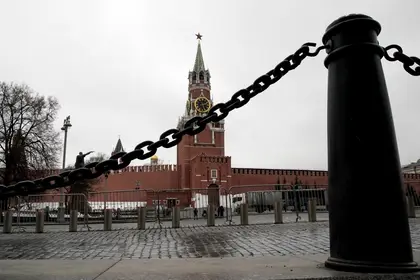Key Takeaways
- Russia continued its campaign of systematic attacks on residential areas in Ukrainian cities with strikes on Vinnytsia, Kharkiv City, and Mykolaiv City.
- Russian forces continued efforts to advance on Siversk but their progress is unclear.
- Russian troops conducted limited ground assaults around Bakhmut and Slovyansk but made no gains.
- Chechen Leader Ramazan Kadyrov claimed that one of the four new battalions he has been forming deployed to Ukraine.
Russia’s operational pause largely continued, with limited Russian ground assaults along the Slovyansk-Siversk-Bakhmut salient. Russian forces continued heavy shelling, missile attacks, and airstrikes all along the front line. The Russians will likely launch a larger-scale and more determined offensive along the Slovyansk-Siversk-Bakhmut line soon, but there are no indications yet of how soon that attack will begin or exactly where it will focus.
JOIN US ON TELEGRAM
Follow our coverage of the war on the @Kyivpost_official.
The Russian missile strike on Vinnytsia on July 14 was part of a systematic Russian campaign of attacks on residential areas of cities in Ukraine.[1] Ukrainian President’s Office Deputy Head Kyrylo Tymoshenko reported that Russian forces launched Kalibr missiles from a submarine at the Vinnytsia city center. The Ukrainian General Staff stated that the strike resulted in at least 22 civilian deaths, about 100 injured, and 39 missing people. Russian forces also launched missiles at a hotel, educational facilities, a shopping center, and transport infrastructure in Mykolaiv city.
Main Effort—Eastern Ukraine
Subordinate Main Effort—Southern Kharkiv, Donetsk, Luhansk Oblasts (Russian objective: Encircle Ukrainian forces in Eastern Ukraine and capture the entirety of Donetsk and Luhansk oblasts, the claimed territory of Russia’s proxies in Donbas)
Russian forces unsuccessfully attempted to improve tactical positions northwest of Slovyansk on July 14. The Ukrainian General Staff reported that Russian forces launched an unsuccessful assault on Kurulka (approximately 27 km northwest of Slovyansk). Russian forces continued to shell settlements southwest and southeast of Izyum and launched an airstrike on Mayaky, approximately 10 km northeast of Slovyansk.

Kyiv Hit by Massive Drone Attack as Russian Strikes Target Multiple Ukrainian Cities
Russian forces continued offensive operations west of the Lysychansk area in an effort to advance to Siversk. The Ukrainian General Staff reported that Russian forces launched an attack on Verkhnokamyanske (approximately 8 km east of Siversk), but Ukrainian forces repelled Russian assaults in the area. Luhansk People’s Republic (LNR) Assistant to the Interior Minister Vitaly Kiselyov amplified Russian war correspondents’ claims that Russian forces established operational control of Siversk on July 14 after seizing Verkhnokamyanske on July 13. Pro-Russian Telegram channel Rybar claimed that Russian forces are still fighting on the outskirts of Verkhnokamyanske. ISW cannot independently verify Kiselyov or Rybar’s claims. The Ukrainian General Staff also reported that Russian forces continued to shell Siversk, Kramatorsk, and settlements in their vicinity throughout July 14.
Russian forces continued to attack settlements southeast of Bakhmut on July 14. The Ukrainian General Staff noted that Ukrainian forces repelled a Russian assault on the Vuhlehirska Thermal Power Plant, Kodema, and Vershyna within a 20 km distance southeast of Bakhmut. Donetsk Oblast Administration Head Pavlo Kyrylenko reported that Russian forces fired at Bakhmut with multiple-launch-rocket systems (MLRS) and shelled Chasiv Yar (west of Bakhmut), likely in an effort to disrupt Ukrainian logistics along the Bakhmut-Kramatorsk-Slovyansk line.
Russian forces resumed offensive operations northeast of Avdiivka, likely in an effort to bypass Ukrainian fortifications in the area. The Ukrainian General Staff reported that Ukrainian forces stopped Russian advances in Kamianka, approximately 6 km northeast of Avdiivka, after Russian forces had been partially successful in the area earlier in the day. The Donetsk People’s Republic (DNR) Territorial Defense claimed that Russian forces captured Kamianka on July 14 but did not provide any evidence confirming the claim. Social media users claimed that Ukrainian forces regained control over Yehorivka, east of the Donetsk-Zaporizhia Oblast administrative border.
Mobilization and Force Generation Efforts (Russian objective: Expand combat power without conducting general mobilization)
Russian regional authorities continued to form and deploy new volunteer battalions to participate in the Russian war in Ukraine on July 14. Chechen leader Ramzan Kadyrov claimed that another unspecified volunteer group deployed to Ukraine. The volunteer group is likely part of one of the four Akhmat volunteer battalions that Kadyrov announced on June 26.
Activity in Russian-occupied Areas (Russian objective: consolidate administrative control of occupied areas; set conditions for potential annexation into the Russian Federation or some other future political arrangement of Moscow’s choosing)
Russian occupation authorities continue to face personnel and workforce shortages in occupied Ukrainian territories. The Ukrainian Resistance Center reported that Russian occupation officials brought electricians from Crimea and Russia to Mariupol to restore electricity, likely due to a lack of skilled personnel in the city. The Ukrainian Resistance Center also found that Russian forces posted a job listing for the position of Melitopol’s Information Security Department Head. The GUR reported that Russian occupation authorities are expecting the arrival of political personnel to organize referendum proceedings in Kherson City. Ukrainian Deputy Defense Minister Hanna Malyar stated that Russian officials began replacing collaborators within occupation administrative structures in Kherson City.
Russian occupation officials continued “passportization” efforts in occupied settlements of southern Ukraine. Russian occupation authorities also opened a pension fund in Melitopol, likely to financially incentivize more pensioners in occupied Zaporizhia Oblast settlements to accept Russian citizenships and use rubles.
DNR Head Denis Pushilin announced that the DNR will use Mariupol’s port to export coal, metal, and grain as well as import Russian construction materials and products. Russian occupation forces will likely continue to use the Mariupol port to transport stolen Ukrainian grain and materials to Russia.
Authors: Kateryna Stepanenko, Grace Mappes, George Barros, and Frederick W. Kagan.
Read the full report here.
You can also highlight the text and press Ctrl + Enter






